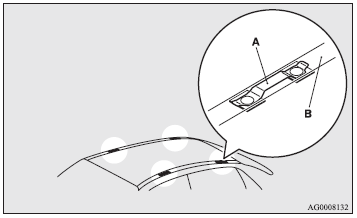Mitsubishi Outlander: Cargo loads
Cargo loads precautions
CAUTION:
● Do not load cargo or luggage higher than the top of the seatback. Be sure that
your cargo or luggage cannot move once your vehicle is moving. Having the rear view
blocked, and your cargo being thrown inside the cabin if you suddenly have to brake
can cause a serious accident or injury.
● Load heavy cargo or luggage in the front of the vehicle. If the load in the back
of the vehicle is too heavy, steering may become unstable.
Loading a roof carrier*
CAUTION:
● Use a roof carrier that properly fits your vehicle. Do not load luggage directly
onto the roof. For installation, refer to the instruction manual accompanying the
roof carrier.
NOTE:
● We recommend you to use a genuine MITSUBISHI roof carrier, since the brackets
to be used have a special shape. For details, we recommend you to consult a MITSUBISHI
MOTORS Authorised Service Point.
Roof carrier mounting brackets

When installing the roof carrier, use the brackets (A). The brackets (A) are located under each roof drip moulding (B).
Roof carrier precaution
CAUTION:
● Make sure that the weight of the luggage does not exceed the allowable roof load.
If the allowable roof load is exceeded, this may cause damage to the vehicle. The
roof load is the total allowable load on the roof (the weight of the roof carrier
plus the weight of luggage placed on the roof carrier). For the specific value,
refer to “Maximum roof load” on page 9-6.
● When luggage is loaded onto the vehicle, please make sure to drive slowly and
avoid excessive maneuvers such as sudden braking or quick turning. In addition,
place the luggage on the carrier so that its weight is distributed evenly with the
heaviest items on the bottom. Do not load items that are wider than the roof carrier.
The additional weight on the roof could raise the vehicle’s centre of gravity and
affect vehicle handling characteristics. As a result, driving errors or emergency
maneuvers could lead to a loss of control and result in an accident.
● Before driving and after travelling a short distance, always check the load to
make sure it is securely fastened to the roof carrier. Check periodically during
your travel that the load remains secure.
NOTE:
● To prevent wind noise or reduction in fuel economy, remove the roof carrier when
not in use.
● Remove the roof carrier before using an automatic car wash.
● Be sure that adequate clearance is maintained for raising the sunroof (if so equipped)
and/or the tailgate when installing a roof carrier.
See also:
Foreword
Your SUZUKI multipurpose vehicle is designed and built to be capable of performing both on pavement and off road. You should therefore remember that your vehicle is distinctly different from ordinary passenger cars in handling as well as in structu ...
Notice to utility vehicle and truck owners
Utility vehicles and trucks handle
differently than passenger cars in
the various driving conditions that
are encountered on streets,
highways and off-road. Utility
vehicles and trucks are not designed
for cornering at speeds as high as
passen ...

 Reversing sensor system*
Reversing sensor system*